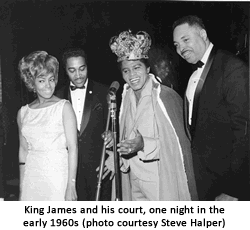The Cape Act
In The One, music journalist R.J. Smith makes an impassioned case for the Godfather of Soul as the most important American musician of the twentieth century
In his poem “In the Funk World,” Amiri Baraka asks, “If Elvis Presley is / king / who is James Brown… / GOD?” This rhetorical question lies at the heart of R.J. Smith’s The One: The Life and Music of James Brown. Smith, an award-winning author and senior editor at Los Angeles Magazine, has bigger game in mind than a mere music biography. The One makes a strong case for James Brown’s stature as the quintessential symbol of the post-bellum journey of Black America in the heart of the South. More significantly, Smith hails Brown as the most important American musician of the twentieth century.
Given these audacious aims, readers might be surprised to discover that the book’s title refers not to the Hardest Working Man in Show Business himself, but to the dominant drumbeat of soul and funk in the world according to James Brown. “The ‘One’ is derived from the Earth itself, the soil, the pine trees of my youth,” Brown once said. “And most important, it’s on the upbeat—ONE two THREE four—not the downbeat, one TWO three FOUR, that most blues are written. Hey, I know what I’m talking about! I was born to the downbeat, and I can tell you without question there is no pride in it. The upbeat is rich, the downbeat is poor. Stepping up proud only happens on the aggressive ‘One,’ not the passive Two, and never on the lowdownbeat. In the end, it’s not about music—it’s about life.” The beat, Smith argues, is not just a sound, but a sensibility, drenched in a history of subversive defiance against oppression.
 Smith launches his account of the unique, near-mystical core of Brown’s soul and style by tracing its origins back to the 1739 Stono Rebellion, twenty miles outside of modern-day Charleston, South Carolina. The rebellion, which left forty blacks and twenty whites dead, resulted in a decade-long ban on the importing of African slaves. More significantly to Smith, it also resulted in the Slave Code of 1740, which barred slaves from possessing or playing the drums the rebels had used, via old Angolan and Congolese rhythms, in calling recruits to swell their ranks. With drums outlawed, the insurrectionary rhythms of self-empowerment found new means of expression. “Writers of the time,” Smith reports, “record a skill amongst slaves for tapping with different parts of their bodies, hitting the floor and walls with sticks, clicking, banging, and most of all, dancing.”
Smith launches his account of the unique, near-mystical core of Brown’s soul and style by tracing its origins back to the 1739 Stono Rebellion, twenty miles outside of modern-day Charleston, South Carolina. The rebellion, which left forty blacks and twenty whites dead, resulted in a decade-long ban on the importing of African slaves. More significantly to Smith, it also resulted in the Slave Code of 1740, which barred slaves from possessing or playing the drums the rebels had used, via old Angolan and Congolese rhythms, in calling recruits to swell their ranks. With drums outlawed, the insurrectionary rhythms of self-empowerment found new means of expression. “Writers of the time,” Smith reports, “record a skill amongst slaves for tapping with different parts of their bodies, hitting the floor and walls with sticks, clicking, banging, and most of all, dancing.”
The One, Smith suggests, flowed directly from the first uprisings of hope and rage, pride and fury, into the irrepressible energy, inexhaustible showmanship, and breathtaking originality of James Brown. The One’s defiant source also points directly at the many contradictions of Brown’s often troubled life and a legacy marred by violence, lawlessness, and harrowing addiction.
Smith can’t be accused of objectivity—his abject adoration of the Godfather seeps onto nearly every page—but his account is exhaustively researched and makes a mostly square accounting of Brown’s triumphs, humiliations, and criminal excesses. Smith dutifully chronicles Brown’s impoverished childhood, his early scrapes with the law, his proclivity for violent outbursts with firearms and against women, his much-documented late-career slide into PCP addiction, and his early support for Al Sharpton. (Brown once told Jesse Jackson that Al Sharpton is “a James Brown act. He’s raw and authentic, and he’s going to outrun you in the end.”) Bizarrely, however, the same James Brown who championed Sharpton also endorsed Richard Nixon’s reelection campaign and enjoyed a close personal friendship with one-time Segregationist Party presidential candidate Strom Thurmond.
 In many ways, The One is most persuasive as a cultural history. The early part of the text focuses on the lives of African Americans in Brown’s home region of “Georgialina”—the Savannah River Valley on both sides of the Georgia-South Carolina border. The violence and prejudice from which Brown emerged makes his ascent all the more remarkable, but for Smith it also explains the origins of his relentless ambition and tireless desire to perform. Smith describes the “Battle Royales” Brown participated in as a young man, competitions in which blindfolded black teenagers were rounded into a ring and ordered to swing wildly at each other until only one was left standing—and for an audience made up exclusively of white men. “When you won,” Smith writes, “here is what they gave you: a shower of coins, all you could stuff in your pockets, perhaps a rustle of bills from the man in charge.”
In many ways, The One is most persuasive as a cultural history. The early part of the text focuses on the lives of African Americans in Brown’s home region of “Georgialina”—the Savannah River Valley on both sides of the Georgia-South Carolina border. The violence and prejudice from which Brown emerged makes his ascent all the more remarkable, but for Smith it also explains the origins of his relentless ambition and tireless desire to perform. Smith describes the “Battle Royales” Brown participated in as a young man, competitions in which blindfolded black teenagers were rounded into a ring and ordered to swing wildly at each other until only one was left standing—and for an audience made up exclusively of white men. “When you won,” Smith writes, “here is what they gave you: a shower of coins, all you could stuff in your pockets, perhaps a rustle of bills from the man in charge.”
Brown never seems to have resented this kind of attention—on the contrary, he worked indefatigably for years to get White America to notice him. Having money thrown at him appears to have figured into the development of one of Brown’s signature stage moves. In early appearances of the Flames (yet to be renamed the “Famous Flames”), white audiences often threw change onstage. “Brown quickly deduced the advantage of busting out a flamboyant stage-front split at such moments,” Smith writes. “He’d be there on the ground, picking up loose change without interrupting the act.” Still, it wasn’t until the legendary T.A.M.I. Show film in 1964—when Brown famously upstaged the headlining Rolling Stones, with Mick Jagger backstage watching agape as the Cape Act made its debut—that the world finally grasped the James Brown phenomenon.
The Cape Act: like The One, it’s a complex system of signs and signifiers—both a contrived flourish and a genuine expression of artistic immersion. At the end of “Please, Please, Please,” Brown falls to his knees and then is led from the stage by a handler who drapes a cape over his shaking shoulders. As the crowd screams “don’t go,” Brown abruptly flings the cape from his shoulders and struts back to the microphone. The ritual repeats itself again and again, each time with Brown appearing more overcome—possessed, even. “It’s a Holiness feeling—like a Baptist thing,” Brown said. “You’re involved and you don’t want to quit. That’s the definition of soul, you know. Being involved and they try to stop you and you just don’t want to stop. The idea of changing capes came later, ‘cause it’s good for show business.”
 As R.J. Smith suggests throughout The One, the Cape Act is also but another means by which James Brown demonstrates his willingness to outwork anyone to prove himself worthy of adoration. As soul gave way to funk, and Brown rode the crest of African-American music through the civil-rights era and on through the Nixon Administration, his identity and stage persona evolved, sometimes troublingly. But his personal determination to be recognized as extraordinary never flagged. In Smith’s estimation, the central irony of Brown’s career was the fact that the very wellspring of his style and form—the legacy of slavery—left him perennially marginalized while the less-gifted Elvis Presley usurped his mantel. “As an artist, as a conductor of American energy, as a master of a nerve-control technique that makes the whole body tremble, Brown was simply greater,” Smith argues. “He just could never make America love him like we love Elvis.”
As R.J. Smith suggests throughout The One, the Cape Act is also but another means by which James Brown demonstrates his willingness to outwork anyone to prove himself worthy of adoration. As soul gave way to funk, and Brown rode the crest of African-American music through the civil-rights era and on through the Nixon Administration, his identity and stage persona evolved, sometimes troublingly. But his personal determination to be recognized as extraordinary never flagged. In Smith’s estimation, the central irony of Brown’s career was the fact that the very wellspring of his style and form—the legacy of slavery—left him perennially marginalized while the less-gifted Elvis Presley usurped his mantel. “As an artist, as a conductor of American energy, as a master of a nerve-control technique that makes the whole body tremble, Brown was simply greater,” Smith argues. “He just could never make America love him like we love Elvis.”
Popular music is perhaps America’s most subjective art form. Reading Smith’s proclamation of James Brown’s superiority to Elvis, one can almost hear the rebuttals forming on the lips of legions of Presley-philes. The Elvis vs. James Brown debate can never be settled, but Smith proves beyond doubt that the Godfather was never content to settle for second place. “James Brown was obsessed with Elvis Presley,” Smith writes. “But it wasn’t the man he liked. Not really. It was the crown.”
R.J. Smith will discuss The One: The Life and Music of James Brown in Nashville at Parnassus Books on April 5 at 6:30 p.m., and on April 6 at 9 a.m. at Vanderbilt University’s First Amendment Center. Both events are free and open to the public, but the Vanderbilt event requires a reservation. Email heather.lefkowitz@vanderbilt.edu for admission.


